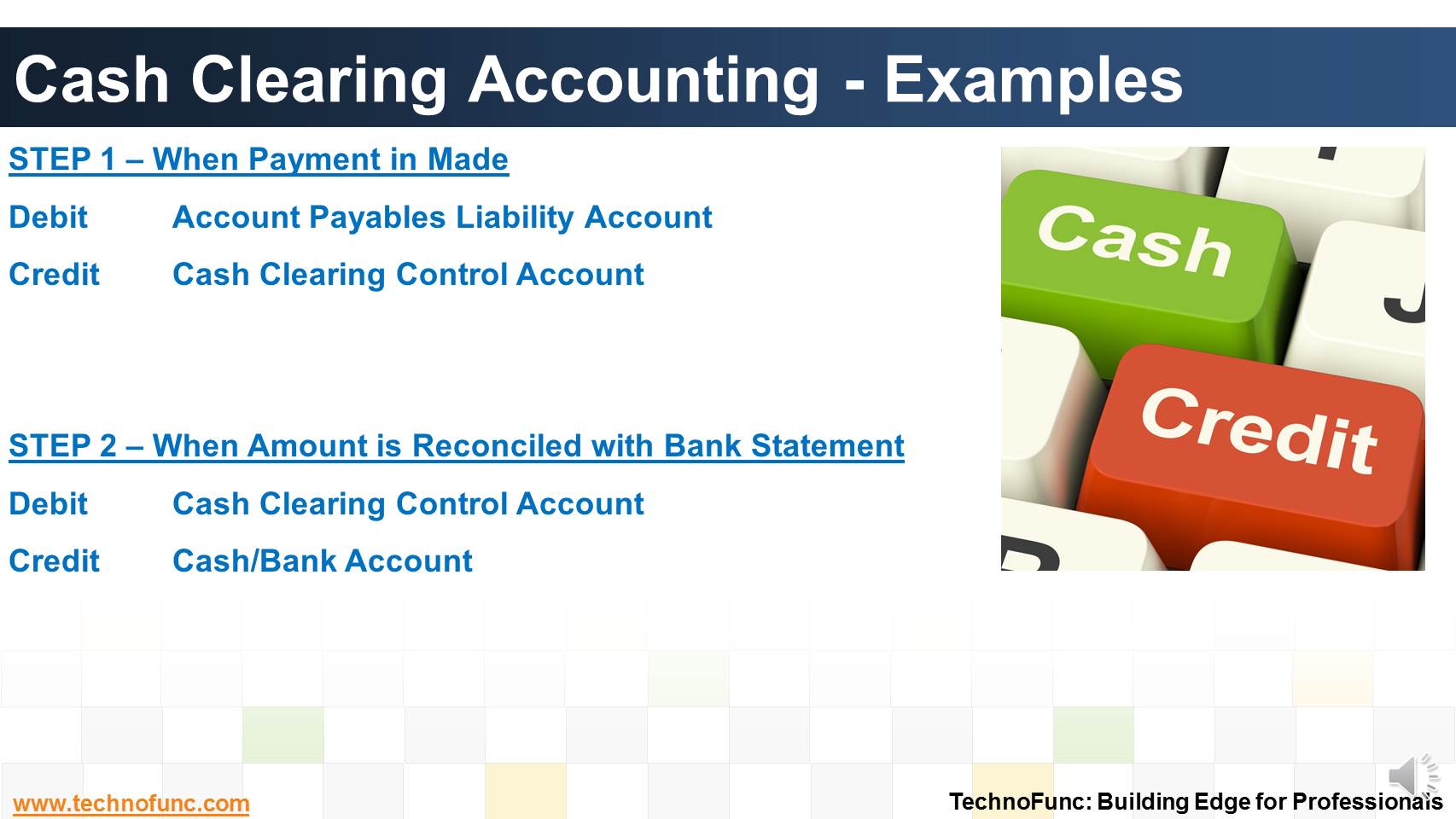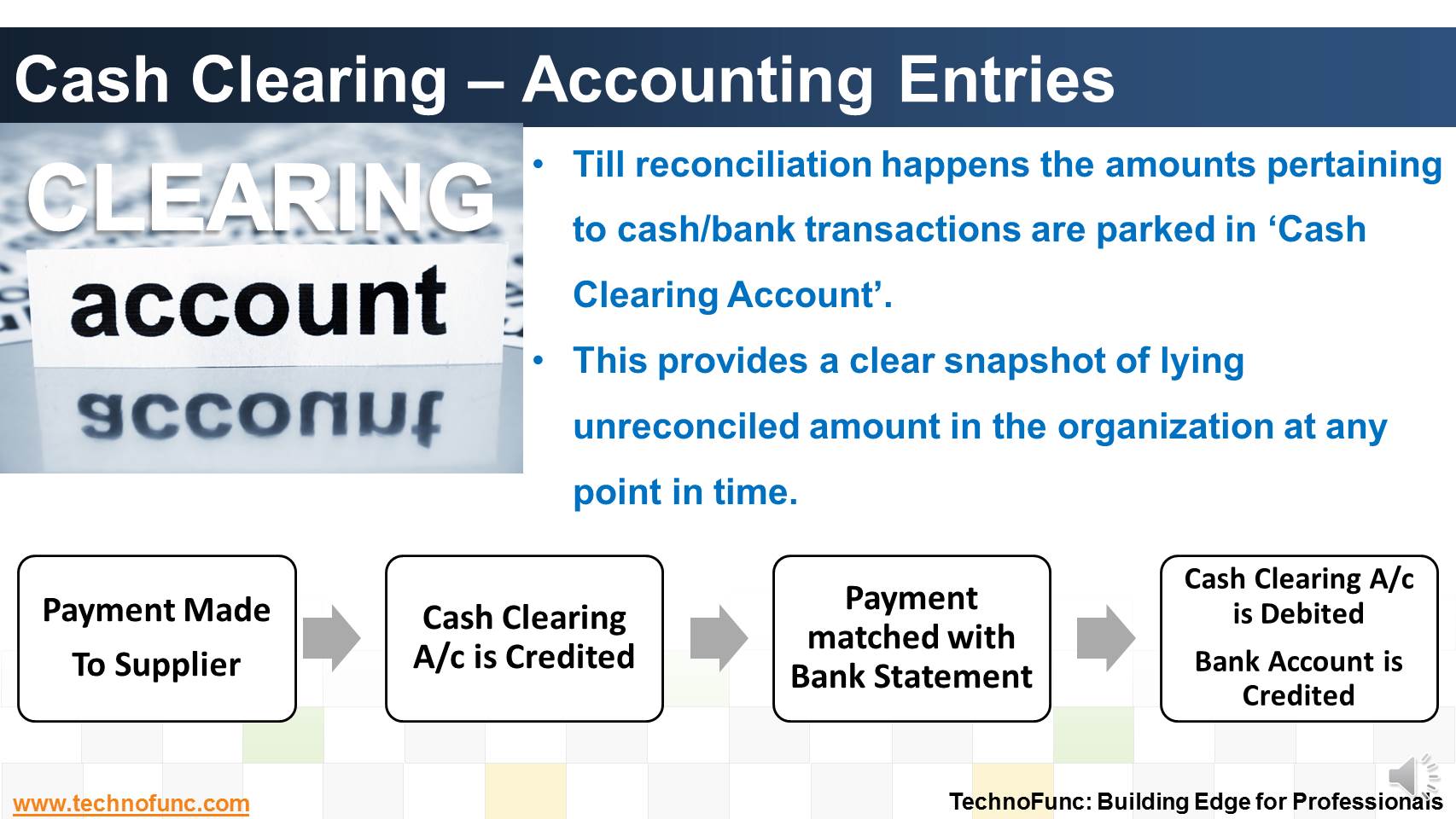- Home
- Business Processes
- Industry Knowledge
- Aerospace Industry
- Automotive Industry
- Banking Domain
- BFSI Industry
- Consumer/ FMCG Industry
- Chemicals Industry
- Engineering & Construction
- Energy Industry
- Education Domain
- Finance Domain
- Hospitality Domain
- Healthcare Industry
- Insurance Domain
- Retail Industry
- Travel and Tourism Domain
- Telecom Industry
- Leadership Skills
- eLearning
- Home
- Functional
- Cash Management
- Cash Clearing – Accounting Entries
Cash Clearing – Accounting Entries
The Cash Clearing process enables you to track amounts that have actually cleared your bank. Learn the steps and accounting entries that gets generated during the cash clearing process.
Cash Clearing Account
Till reconciliation happens the amounts pertaining to cash/bank transactions are parked in 'Cash Clearing Account'.
This method focuses on the use of a special cash-clearing control account to help provide an accurate cash-on-hand balance by including the effect of cash/bank transactions that have been issued, but have not yet cleared the bank in reconciliation system.
This provides a clear snapshot of lying unreconciled amount in the organization at any point in time.
For example – when you release payment to any supplier for his due invoice
You typically Dr Supplier A/c and Credit Bank Account
However in Cash Clearing Method – when you issue payment
You will Dr Supplier A/c and Credit Cash Clearing Account
Later when you receive the bank statement and reconcile the payment – at that point you will generate another accounting entry:
That is Cash Clearing A/c is Debited and Bank Account is Credited
Hence at this stage the payment hits your bank account – keeping it always reconciled.
Accounting Entries – Cash Clearing Process
The Cash Clearing process creates accounting entries for each scheduled payment that has been paid, reconciled, and cleared for bank accounts using cash clearing method of reconciliation.
These accounting entries are then posted to the general ledger.
Cash/Bank Clearing account is used to record unidentified debits and credits in bank statement.
At the time of reconciliation process, we have to debit or credit main account and offsetting will be done to Cash/Bank Clearing account.
Then only balance in the main account will match with Bank Statements.
Cash Clearing Accounting Examples
Cash clearing accounting for cash/bank transactions is a two-step process.
Step 1
When the payment is issued and posted, the accounts payable liability account is debited, and the cash clearing control account (as opposed to the actual cash account) is credited for the payment amount.
Step 2
Later, when the cash clearing request is processed, a pair of balanced accounting entries are created to clear the net cash amount of the issued payment for each payment that has been reconciled.
To determine the actual cash balance, add any debit or credit residue in the cash clearing control account from payment or deposit amounts that have not yet been cleared to the cash account balance.


Related Links
You May Also Like
-
Bank Reconciliation is a PROCESS to Validate the bank balance in the general ledger With Bank Statement. Learn the bank recon process.
-
Bank reconciliation process is targeted to validate the bank balance in the general ledger and explain the difference between the bank balance shown in an organization's bank statement. Learn the reasons for existence of differences between the two.
-
Treasury has increasingly become a strategic business partner across all areas of the business, adding value to the operating divisions of the company. Managing activities that were traditionally carried out within the general finance function. Learn about the drivers for this change.
-
What is Account Reconciliation?
Before you understand the Bank Reconciliation Process it is important to understand what is account reconciliation and why it is carried out.
-
So many codes in the lines that are there in a Bank Statement. It contain lots and lots of meaningful information that can help automated many tasks. Explore more!
-
Disbursement Float is the time taken from payment creation to settlement. Collection float is the sum total of time taken by Payment Float; Mail Float; Processing Float and Availability Float. Learn more!
-
Many different accounts are used in finance. Understand the representation and nature of clearing account in context of accounting, finance and ERP Systems.
-
The objective of funding Management is to implement strategies that lead to the best borrowing rates and lower investment costs. Learn how treasury aids in loans and investment management functions.
-
Cash Clearing – Accounting Entries
The Cash Clearing process enables you to track amounts that have actually cleared your bank. Learn the steps and accounting entries that gets generated during the cash clearing process.
-
What are the various sources of cash in an organization. Which sources increase the cash available with the enterprise and which sources results in outflow of the cash? Let us explore!
Explore Our Free Training Articles or
Sign Up to Start With Our eLearning Courses

About Us
Learning
© 2023 TechnoFunc, All Rights Reserved










